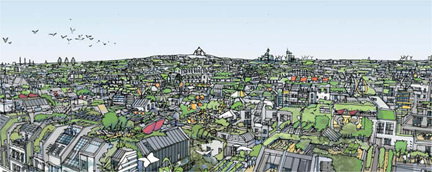Ecology at the heart of the project
by Marco Chown Oved
Article published on the 2009-03-27 Latest update 2009-05-08 09:08 TU
Two themes were selected for the consultation. The first, more abstract and creative, is “The post-Kyoto 21st Century metropolis”. The second, more applied and technological is “the prospective diagnosis of Parisian amalgamation”, a mouthful which means balancing the city's attributes with its challenges.
The post-Kyoto metropolis
The Kyoto protocol on limiting greenhouse gases was signed ten years ago. It was the first international treaty to commit countries to reducing their emissions of the gases that are behind global warming.
Since that time, we've come to realise that it's not just our use of transport and electricity that we need to change, but the very way we organise our societies – starting with cities.
The backbone of Paris Métropole is the idea that sustainability and development towards a more ecologically-friendly way of life must be at the centre of any future development.
To reach this goal, the architects were asked a series of questions to structure their proposals. Faced with increasingly rapid and uncontrollable urban development, how can we rethink the use of space to incorporate all the different stakeholders’ needs?
What kind of strategy can be developed to rethink energy use in order to strike an ecological equilibrium?
Paris's special situation
Secondly, the architects were asked to consider Paris's specific historical context, political situation and geographic challenges. Drawing on similar projects in London, Madrid and Berlin, Paris would like to borrow the best from these initiatives, yet tailor them to a French context.
Paris Métropole calls on the architects to improve upon these and capitalise on the French capital's unique geography, history and reputation for innovation.








